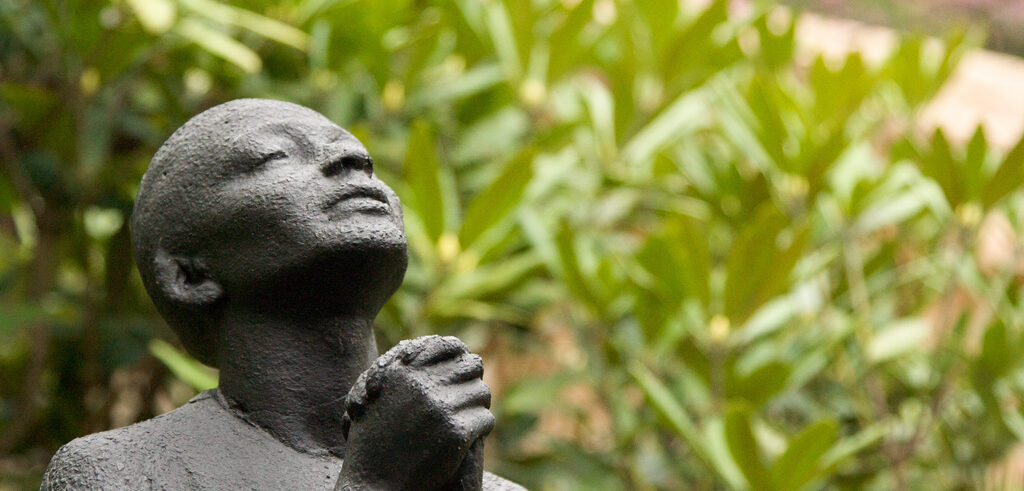Commentary on Mark 14:22-42
The story of Jesus’ last supper has informed two thousand years of eucharistic theology and practice. Many Christians, like myself, hear the story every Sunday before they approach the altar and receive the elements. This practice is often undergirded by the conviction that we are receiving Jesus himself. Jesus is mysteriously present in the meal.
Informed by this tradition, it is easy to project details from other sources into Mark’s version of the story. Yes, the Markan Jesus connects the bread and wine to his body and blood and, in so doing, suggests a connection between the meal and his impending death. But the wine is not, in Mark’s version, the blood of the “new” covenant (see also Luke 22:20; 1 Corinthians 11:25). It is simply the “blood of the covenant,” presumably a reference to the annual Passover sacrifice.
Nor does Jesus connect the meal to the forgiveness of sins (see also Matthew 26:28), perhaps because he has already shown the authority to forgive sins well before his death (Mark 2:5-12, 17; see also 1:4). Finally, Jesus does not institute an ongoing ritual (see also Luke 22:19; 1 Corinthians 11:24-25), meaning we are probably meant to experience the story as a truly (and tragically) last supper, at least until God’s kingdom is fully consummated at the eschaton (Mark 14:25).
Of course, the preacher is always free to draw on various scriptural, doctrinal, and liturgical traditions in her appropriation of Mark. That is what good theology always does. Still, it helps to spend some time tending to Mark’s distinctive description of this scene as informed by his overall narrative. Doing this, I am drawn to the complementary themes of divine liberation and faithfulness.
Jesus’ last supper was a Passover meal, a meal that commemorated God’s liberation of the Hebrews from slavery in Egypt. More than any other event, this liberation defined the people’s covenant with God. Their God was a liberating God, and they were God’s freed people. This was the case chiefly by virtue of God’s faithfulness to their ancestors Abraham, Sarah, Isaac, Rebekah, and Jacob. Faithfulness and liberation go hand in hand.
Moreover, when God guided this freed people to Sinai and ratified the covenant through various commandments, God was careful to include regular liturgies of atonement (Leviticus 16). Why? Because divine forgiveness moves this story of faithfulness and liberation to its natural conclusion. Just as God freed the people from physical bondage in Egypt, so God pledges to free the people from their own disobedience. Divine mercy proves a key dimension of divine faithfulness.
In Mark’s Gospel, the mission of Jesus is likewise one of liberation and faithfulness. Jesus heals the physically infirm (Mark 1:40–3:12; 5:21–43; 6:54–56; 7:24–37; 8:22–26; 10:46–52), he reaches out to the marginalized and neglected (Mark 2:13–17; 9:36–37; 10:13–16; 14:40–41), and, as previously noted, he forgives sinners (Mark 2:5–12, 17). Jesus is determined to liberate people from anything that hinders their well-being as intended by their Creator (pain, isolation, guilt, etc.). No wonder, then, that Mark refers to Jesus’ ministry as “the kingdom of God” (Mark 1:14–15; 4:1–34). Through this ministry Israel experiences God’s faithfulness and liberation in a particularly powerful—even climactic—way.
I say “climactic” because, while Jesus’ ministry continues the past work of God, it is not simply restoring a past dynasty (see Mark 12:35–37). It is, rather, a foretaste of the eschatological kingdom, the ushering in of the messianic age, the full consummation of which occurs only as Jesus comes “in clouds with great power and glory … to gather his elect from the four winds” (Mark 13:26–27).
In his last supper, the Markan Jesus makes clear that this messianic, Passover liberation entails his own death and resurrection. Jesus identifies his soon-to-be-broken body and -shed blood with the very meal that commemorates God’s liberating faithfulness toward Israel (verses 22–24). He then promises continued fellowship and ministry after he is raised up to new life: “After I am raised up, I will go before you to Galilee” (verse 28).
Of course, Jesus has already foretold this movement from death to life in multiple conversations with his disciples (Mark 8:31; 9:31; 10:33–34). But now the liberating significance of that movement comes to the fore. By virtue of his death and resurrection, Jesus’ ministry of human healing and well-being will not stop at the cross. Disciples will not be tasked with picking up the mantle of a dead Jesus. Rather, Jesus himself will continue to gather them and lead them. Paralytics and lepers will continue to be healed. Sinners will continue to know forgiveness and inclusion. The good news of God’s kingdom will continue to be proclaimed in anticipation of its full eschatological in-breaking.
The promise of social restoration is particularly significant given the disintegration that is now beginning. While Judas Iscariot still benefits from anonymity, everyone now knows that a betrayer eats in their midst (Mark 14:10–11, 17–21). Soon after the meal, on the Mount of Olives overlooking Jerusalem, Jesus prepares the incredulous disciples for their impending abandonment, going so far as to connect that desertion to biblical prophecy: “I will strike the shepherd, and the sheep will be scattered” (verse 27, citing Zechariah 13:7). He then singles out Peter, warning him of his threefold denials (verse 30). Even as Jesus prays in Gethsemane in the darkest hour prior to his arrest, the disciples prove unable to comfort and console (verses 32–42). The tragic isolation of Golgotha has already begun.
Reflecting on the last supper with this social disintegration in mind, it is hard to overstate the magnitude of Jesus’ faithfulness. Knowing full well the extent of his followers’ impending infidelities, Jesus gathers them to celebrate God’s liberating faithfulness to them (Passover), and he does so by giving himself to them. On the one hand, this is quite consistent with Jesus’ actions throughout the narrative, for every time the disciples struggle in their understanding and execution, Jesus is there to explain and encourage (for example, Mark 4:33–34; 6:35–44). But now there is an implied invitation to receive Jesus—the crucified Jesus—himself. It seems the disciples are no longer simply followers and learners but, in some sense, participants in that final movement from death to new life.
Of course, this is far from the developed sacramental theology of later Christian reflection. But that is precisely what makes Mark’s account distinctive. For Mark, the last supper connects disciples to the liberating work of a faithful Creator, offers them a foretaste (literally and metaphorically) of the messianic age, and draws them mysteriously into Jesus’ climactic life-giving sacrifice. At the table, disciples find assurance that their own abandonment of Jesus will not prevent him from bringing them into a share of his new, risen life.
PRAYER OF THE DAY
Holy Jesus, the bread and wine of your last supper have become your body and blood, given for us. Transform us with your holy presence. Cleanse us, forgive us, and renew us in your word. Amen.
HYMNS
For the bread which you have broken ELW 494, GG 516, H82 340/341, UMH 614/615
Go to dark Gethsemane ELW 347, GG 220, H82 171, UMH 290, NCH 219
CHORAL
Jesus, I adore thee, Stephen Caracciolo


March 28, 2024